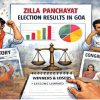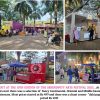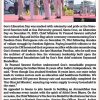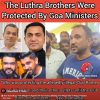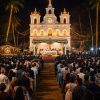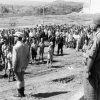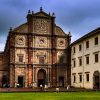Goa is abuzz with excitement as vintage bike and car owners, users, collectors and fans are decking […]
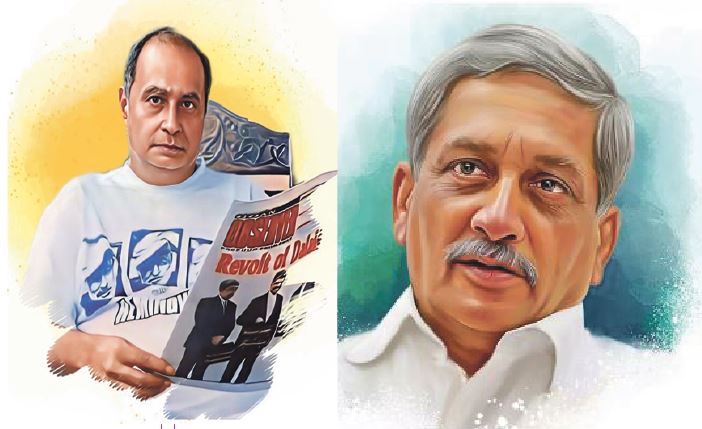
Rajan Narayan…MEMOIRS OF AN UNDERDOG JOURNALIST! `I have no sacred cows!’ `I’m the goonda with the pen!”
July 27- Aug 02 2024, Life & Living July 26, 2024THE SURGICAL STRIKES OF MANOHAR PARRIKAR
By Rajan Narayan
MANOHAR Parrikar was born in the village of Parra in north Goa. Parra is famous for the biggest, tastiest watermelons. The story goes that the farmers in Parra used to invite the village children to feast on the watermelons. There was one condition. The children had to gather all the seeds. These were then replanted to ensure a new crop of watermelons of the same quality. Thus, the genetic purity of the watermelons was protected. It’s a favorite Manohar Parrikar story.
Parrikar was a graduate of the Indian Institute of Technology and he led the Goa group of RSS which participated in the demolition of the Babri Masjid. Manohar Parrikar contested unsuccessfully in the North Goa Lok Sabha elections in 1996. At the invitation of the then RSS chief Shubash Velingkar, Manohar Parrikar decided to contest the Panaji assembly seats in 1999. Parrikar was groomed by Velingkar majorly to be chief minister.
Parrikar and three other BJP candidates were elected for the first time to the Legislative Assembly of Goa in 1999. Luizinho Faleiro became the chief minister on June 9, 1999 as the Congress got a clear majority. But within five months on November 11, 1999 the government was toppled by rebel Congressman MLA Francisco Sardinha.
Manohar Parrikar and his BJP MLAs extended support to Francisco Sardinha. When Francisco Sardinha went abroad, Manohar Parrikar in a surgical strike withdrew support and toppled the Sardinha government. He appointed himself the chief minister on October 24, 2000 and remained chief minister till February 2, 2005. Just a little short of finishing his full term as chief minister.
Manohar Parrikar only managed to hold on to the chief minister’s kodel because of the support of Atanasio Monserrate (Babush). In turn Babush demanded and got the Town & Country Planning portfolio. When it looked as though the Parrikar government would lose its majority, Babush again came to the rescue of Parrikar. Babush resigned his seat and persuaded the Cumberjua MLA Pandurang Madkaikar and the Canacona MLA Isidore Fernandes to quit their Congress seat and contest again on the BJP ticket. Parrikar also got the support of Matanhy Saldanha, the United Goans Democratic Party MLA. Parrikar still fell short of a majority in the legislative assembly.
On the eve of the confidence vote Parrikar moved his MLAs to Rajasthan which was then a BJP-ruled state. They were placed under the charge of Digambar Kamat, the most trusted confidant of Manohar Parrikar. Parrikar was shocked when he was told that the “shepherd of the flock” Digambar Kamat had come back to Goa and was planning to defect to the Congress.
I was in Margao with my wife on the day Digambar Kamat defected to the Congress. Businessman Datta Naik had gone to pick up Digambar Kamat to drive him to the Ramada Hotel. At the Ramada the Congress High Command Observer Margaret Nazareth Alva was waiting to welcome Digambar Kamat. Mining and hospitality baron Avdhoot Timblo was also in Margao. When Digambar was planning to move out, Manohar Parrikar suddenly landed at his flat in Borda, Margao. Parrikar tried to persuade Digambar to stay back in the BJP. Digambar refused and Parrikar left Margao.
Soon after Digambar accompanied by Avdhoot Timblo and Datta Naik drove to the Ramada Hotel and joined the Congress party meet there. In the assembly session that followed Parrikar attempted another surgical strike. Parrikar tried to disqualify Filipe Neri Rodrigues, MLA of Velim, claiming that he had become a primary member of the BJP.
The speaker who was Parrikar’s man even expelled Filipe Neri. However, in the confusion that followed the Speaker claimed that Parrikar had won the vote of confidence. The Parrikar government was dismissed by Governor Bhanu Pratap Singh Varma and Pratapsingh Raoji Rane was appointed as chief minister on February 3, 2005 — the day after the Parrikar government was dismissed.
But the Rane government could survive only for one month from February 3 to March 4, 2005. President’s Rule was declared on March 4, 2005 as no party had a clear majority. At the end of presidential rule in June 2005 fresh elections were held. Pratapsingh Roaji Rane was again appointed as chief minister to complete the term of the legislative assembly and he remained chief minister till June 7, 2007.
In the 2012 assembly elections Manohar Parrikar returned to power but served as chief minister only for less than two years from March 9, 2012 to November 7, 2014. Parrikar resigned to join the Central government led by Narendra Modi as the Defense Minister of India. Perhaps because of his poor health Manohar Parrikar resigned as Union Defense Minister and returned to Goa as chief minister on March 14, 2017. He died of cancer of the pancreas on March 17, 2019 and was cremated on at the samadhi at Miramar beach on March 18, 2019.
I first met Manohar Parrikar in 1999 when he was still an ordinary MLA of the BJP. Manohar Parrikar had tremendous talent for public relations. He used to visit the press room at the Adil Shah Palace frequently and made friends with all the journalist by offering them stories on the Congress government. My then chief reporter Julio D’Silva brought Manohar Parrikar to the OHeraldo office and introduced me to him. I found Manohar Parrikar very interesting as he was educated, intelligent and had a sense of humor. I immediately recognized that here was a long distant runner. Or as they say in Hindi, “lambi race ka ghoda (horse).”
We became and remained friends and I was not surprised when he became chief minister of Goa after toppling the Sardinha government which was very corrupt. The Sardinha government became bankrupt due to its spending sprees. The government had no funds and ask the Economic Development Corporation to raise Rs51 crore to pay salaries. It was the practice to appoint an investment broker to raise funds. Sardinha offered a commission of almost 3% to the broker instead of the tradition 0.5%.
Manohar Parrikar exposed the EDC bond scam to justify toppling the Sardinha government. Many Congress MLAs including Alexio Sequiera, the present environment minister, supported Manohar Parrikar. On the day Manohar Parrikar was sworn in as chief minister he came from the Raj Bhavan to my underground basement flat at Dona Paula to seek my blessings. I congratulated Manohar Parrikar and toasted him with some red wine.
Soon after he took over as chief minister in December 2000 he invited my wife Tara and me for dinner in the private dining room of the International Centre of Goa at Dona Paula. The only other person present with us was his younger son Utpal Parrikar. Parrikar had lost his wife Medha Parrikar to blood cancer just before he was elected as an MLA. There was no one to look after his younger son who accompanied him wherever he went.
We had a long discussion on what he could do for the development of Goa. At the end of the evening we had become good friends. But Tara was very shocked when the next day the ICG restaurant manager came to our flat and presented us with the bill for the previous night’s dinner. We told him that it was Parrikar who had invited us for dinner. Anyway we paid the bill. This happened for second time too when Parrikar again invited us for dinner at the same venue. This time I sent the bill to Parrikar. Parrikar told me that he had assumed that the International Centre would not present him with a bill as they had asked for a government Rs1 crore grant for expansion of ICG.
Slowly I learnt that Manohar Parrikar had zero tolerance for any criticism. There was a dengue epidemic in Panaji during the monsoon season of 2001. All the popular restaurants were closing down from cafes Bhonsle to Tato to Real for cleaning up operations. The provocation was that there was an incident of leakage of the sewage pipeline at Neptune hotel. The sewage water had got mixed with the drinking water supply. A red alert had been sounded and even the panipuri gaddo at Miramar beach were told to shut down. Sanjit Rodrigues was the first commissioner of the newly formed Corporation of the City of Panaji.
Tara and I were attending a dinner party at OCoqueiro’s at Porvorim. We were told by one of the guests that Manohar Parrikar’s favourate eatery was a gaddo serving ros-omlet outside at the open streetside stalls of the Alankar Cinema in Mapusa. Though it was late night we decided drive down to Alankar Cinema to see for ourselves the truth and if Parrikar would be there; as it happened he was not there but was expected. The owner of one of the gaddo confessed that he waited for the chief minister sometimes even till 2am.
Tired we went home but the next day Tara Narayan wrote a anchor piece which appeared on the front page of the OHeraldo, it was titled, “Is this where the chief minister of Goa dines?” At filthy gaddo eateries at the height of the malaria and dengue epidemic outbreak in Panaji and the crackdown on popular Goan eateries. By 7am in the morning the next day after the newspaper was on stands Manohar Parrikar called my residence and Tara picked up the phone. Manohar Parrikar insisted that he does not go to the famous gaddo place at Alankar Cinema at Mapus to eat but to drink coconut water.
When confronted with photographs and evidence he claimed that he shrugged it off. Parrikar wanted an apology to be pulished which I refused. He promptly called the owner Raul Fernandes of the OHeraldo to stop Tara Narayan from writing for OHeraldo. She stopped writing the odd write-ups she used to do after we had got married on February 10, 2001 and was looking for a job herself.
A little later I was exposed to the ruthless streak in Manohar Parrikar. Parrikar had persuaded Information & Broadcasting Minister Sushma Swaraj to shift the International Film Festival to Goa. Sushma Swaraj agreed and the first IFFI was scheduled to be held in November 2003 in Panjim in Goa.
Parrikar got into a frenzy to create the infrastructure for IFFI. A large part of the municipal market was demolished to make way for the INOX multiplex at the Old GMC complex, it is not widely known that the INOX multiplex was built by the Goa government at the expense of the tax-payers money. INOX was leased out to a Gujarat party to run.
The Dayanand Bandodkar football stadium was also all set to be demolished to be build new infrastructure for IFFI. This was abandoned for want of time. Parrikar undertook the renovation of Panaji from the Dona Paula jetty which was the venue of the inaugural ceremony of IFFI. An estimated over Rs50 crore were spent on the renovation including Rs20crores on refurbishing the Kala Academy venue alone.
The entire GMC complex in Panaji was transformed. The GMC itself had earlier shifted to its present premises at Bambolim. For the benefit of the aam aadmi Goans to see films the National Water Institute at Ivoae village at Dona Paula was cleaned up for an IFFI venue to screen films; so involved was the chief minister with IFFI infrastructure that he even ignored an international summit on informational technology organized by his colleague Ramakant Khalap, who was his IT minister.
But to give credit to Manohar Parrikar, he single-handedly created the infra-structure for IFFI in Goa. Sadly, even after 20 years of IFFI, Goa does not have a proper one permanent venue for IFFI.
My breaking point with Parrikar came in 2003. Manohar Parrikar had brought out a White Paper on the mess in the Economic Development Corporation (EDC). Parrikar put the blame on former chief minister Luizinho Faleiro. The charge was that the EDC gave loans at huge rates of interest to defaulting steel rolling mills. Luizinho Faleiro, in turn, who was the Leader of the Opposition, accused Parrikar of granting major favors to his brother-in-law Raju Sanqualkar for a one time settlement for the dues of SimChem.
Luizinho Falerio brought out a Black Paper on Manohar Parrikar. When the news broke out in the newspapers an angry Manohar Parrikar got his south Goa lawyer friend Narendra Sawaikar to issue a legal notice to all newspapers in Goa in January 2003 barring them from publishing anything about his family. This notice received stiff resistance in the media. This was the first time any chief minister had sought to silence Goan media. Manohar Parrikar was forced to withdraw the legal notice but I decided to quit the OHeraldo, over a dispute with proprietor Raul Fernandes about the small matter of carrying a news report about the legal notice sent to newspapers.
After 20 years of editing the OHeraldo my disillusionment and disgust was complete and I resigned and picked up my bag and walked out of the OHeraldo with practically little in my pockets. Those were not the years when journalists could earn big money, especially if they were honest to the point of self-annihilation.
Since I had seen the ugly face of Parrikar I campaigned against him in the 2007 assembly election in the Goan Observer weekly which I started after quitting OHeraldo. Among the leaders who discussed matters with Manohar Parrikar was businessman Datta Naik, he was also a political social activist in Margao and the chairman of his own real estate firm Commonwealth Developers. Datta Naik brought out a 12-page supplement on the sins of omission and commission of Manohar Parrikar in Konkani. Over three lakh copies were distributed all over Goa. It is a matter of satisfaction that the BJP lost the election in 2007 and the Congress came back to power.
Ironically, Digambar Kamat, who had defected from the BJP, became the chief minister of Goa.



